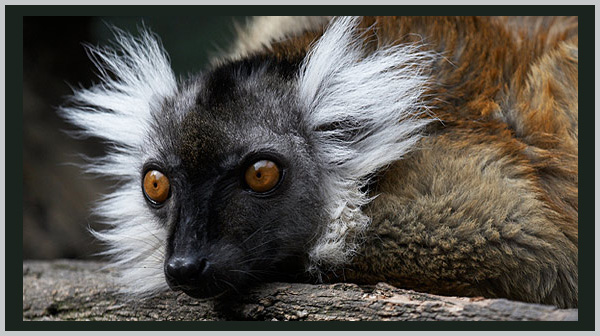
Black Lemur
Name: Black Lemur (Eulemur macaco)
Conservation Status: Endangered (2021 IUCN Red List)
Population Estimate: Decreasing
Range: Madagascar
Threats: Agriculture / Hunting and Trapping / Logging / Mining & Quarrying
The black lemur is one of 28 species of lemurs, which are primitive relatives to monkeys and apes. The black lemur is unique among lemurs in that males and females are different colors. Its name comes from the coloration of the male, which is uniformly black, while the female is a dark brown to rust color with white undersides. This difference in appearance is so striking that for years males and females were thought to be different species.
Species Description and Range
The black lemur is a medium-sized lemur, with an overall length (head to tip of tail) of about 38 inches (96 cm), weighing about 5 pounds (2 kg). The fur is luxuriant and the ears are lavishly tufted with long hair, which is black in males and white in females.
Black lemurs are limited to the extreme northwestern tip of Madagascar and a few outlying islands. Their natural habitat is undisturbed tropical rain forest, but black lemurs have been reported in regenerated (secondary) forest, tree farms, and croplands with trees (such as coffee and cashew plantations).
Like most lemurs, black lemurs are social. They live in groups of 7 to 10 related individuals. They are omnivores, feeding on ripe fruit, leaves, flowers, insects, and the occasional small vertebrate. Because of their fruit-eating, transient ways, lemurs are important agents of seed dispersal through their droppings.
Causes of Endangerment
Habitat Loss, Overexploitation
The primary threat to lemur survival is deforestation due to slash-and-burn agriculture, logging, charcoal and firewood production, and burning to create cattle pasture or single-species tree farms. Lemurs also are hunted for food and captured for pet trade or zoos. Black lemurs are sometimes killed because they raid crops.
Conservation Actions
Madagascar is the world’s highest priority for primate conservation. It is one of the best examples of the uniqueness of island evolution, with primate species that occur nowhere else on Earth (see Island Biogeography). Lemurs are the most attractive and best-known of Madagascar’s wildlife.
Two new species of lemur were discovered in the late 1980s, evidence of how little is yet known about Madagascar’s ecosystems (see Spotlight on the Hairy-Eared Dwarf Lemur).
Habitat Protection and Tourism
The black lemur’s apparent adaptability to disturbed habitat and tolerance of people give it a better chance of survival in proximity to humans than is the case for less adaptable lemurs (see Spotlight on the Aye-Aye).
Local people initially protested the creation of the Ranomafana Park, a national reserve protecting a corridor 10 to 15 miles (16 to 24 km) wide along the coast of eastern Madagascar, one of the island’s largest areas of remaining virgin rain forest.
Eleven kinds of lemurs live in Ranomafana Park, including some found nowhere else. This patch of forest had been spared destruction because of its location on steep hillsides, unusable for slash-and-burn agriculture and because it is difficult to log.
A cyclone in 1985 triggered landslides on surrounding denuded hillsides, killing many people, destroying homes, and teaching local villagers that it is in their interest to spare the remaining virgin forest. Efforts are now being made to replant barren slopes with fruit trees and restore irrigation channels to revive abandoned rice fields, improving the lives of the local people while restoring habitat.
The growth of ecotourism may provide the strong economic incentive necessary for the Malagasy people to preserve natural habitats. Hot springs and the attraction of unique animals offer promise for tourism and jobs.
Captive Breeding
Lemurs breed fairly well in captivity and are popular in zoos worldwide. Reintroduction of captive-bred lemurs may be used in the future to boost wild populations.
Questions for Thought
What factors make plants and animals native to islands so vulnerable to extinction?
How far can ecotourism go toward conserving endangered lemurs? What things necessary to conservation might ecotourism not accomplish?
Explore:
Related Classroom Activities:
[CS1-1, CS1-3, CS2-2]
Click here for Endangered Species Classroom Glossary
External Link(s)
Lemurs of Madagascar – A Strategy for Their Conservation – an IUCN Report